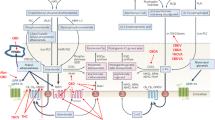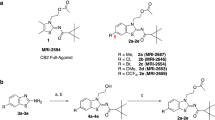Abstract
The endocannabinoid (eCB) system, consisting of eCB ligands and the type 1 cannabinoid receptor (CB1R), subserves retrograde, activity-dependent synaptic plasticity in the brain. eCB signaling occurs “on-demand,” thus the processes regulating synthesis, mobilization and degradation of eCBs are also primary mechanisms for the regulation of CB1R activity. The eCBs, N-arachidonylethanolamine (AEA) and 2-arachidonoylglycerol (2-AG), are poorly soluble in water. We hypothesize that their aqueous solubility, and, therefore, their intracellular and transcellular distribution, are facilitated by protein binding. Using in silico docking studies, we have identified the nonspecific lipid binding protein, sterol carrier protein 2 (SCP-2), as a potential AEA binding protein. The docking studies predict that AEA and AM404 associate with SCP-2 at a putative cholesterol binding pocket with ∆G values of −3.6 and −4.6 kcal/mol, respectively. These values are considerably higher than cholesterol (−6.62 kcal/mol) but consistent with a favorable binding interaction. In support of the docking studies, SCP-2-mediated transfer of cholesterol in vitro is inhibited by micromolar concentrations of AEA; and heterologous expression of SCP-2 in HEK 293 cells increases time-related accumulation of AEA in a temperature-dependent fashion. These results suggest that SCP-2 facilitates cellular uptake of AEA. However, there is no effect of SCP-2 transfection on the cellular accumulation of AEA determined at equilibrium or the IC50 values for AEA, AM404 or 2-AG to inhibit steady state accumulation of radiolabelled AEA. We conclude that SCP-2 is a low affinity binding protein for AEA that can facilitate its cellular uptake but does not contribute significantly to intracellular sequestration of AEA.






Similar content being viewed by others
Abbreviations
- 2-AG:
-
2-Arachidonoylglycerol
- AEA:
-
N-Arachidonylethanolamine
- ANOVA:
-
Analysis of variance
- CB1R:
-
Type 1 cannabinoid receptor
- eCBs:
-
Endocannabinoids
- ECS:
-
Endocannabinoid signaling
- SCP-2:
-
Sterol carrier protein 2
References
Katona I, Freund TF (2012) Multiple functions of endocannabinoid signaling in the brain. Annu Rev Neurosci 35:529–558. doi:10.1146/annurev-neuro-062111-150420
Fowler CJ (2013) Transport of endocannabinoids across the plasma membrane and within the cell. FEBS J 280(9):1895–1904. doi:10.1111/febs.12212
Hillard CJ, Jarrahian A (2003) Cellular accumulation of anandamide: consensus and controversy. Br J Pharmacol 140(5):802–808
Sanchez ER (2012) Chaperoning steroidal physiology: lessons from mouse genetic models of Hsp90 and its cochaperones. Biochim Biophys Acta 1823(3):722–729. doi:10.1016/j.bbamcr.2011.11.006
Muccioli GG (2010) Endocannabinoid biosynthesis and inactivation, from simple to complex. Drug Discov Today 15(11–12):474–483. doi:10.1016/j.drudis.2010.03.007
Tsou K, Nogueron MI, Muthian S, Sanudo-Pena MC, Hillard CJ, Deutsch DG, Walker JM (1998) Fatty acid amide hydrolase is located preferentially in large neurons in the rat central nervous system as revealed by immunohistochemistry. Neurosci Lett 254(3):137–140
Yoshida T, Fukaya M, Uchigashima M, Miura E, Kamiya H, Kano M, Watanabe M (2006) Localization of diacylglycerol lipase-alpha around postsynaptic spine suggests close proximity between production site of an endocannabinoid, 2-arachidonoyl-glycerol, and presynaptic cannabinoid CB1 receptor. J Neurosci 26(18):4740–4751
Gulyas AI, Cravatt BF, Bracey MH, Dinh TP, Piomelli D, Boscia F, Freund TF (2004) Segregation of two endocannabinoid-hydrolyzing enzymes into pre- and postsynaptic compartments in the rat hippocampus, cerebellum and amygdala. Eur J Neurosci 20(2):441–458
Kaczocha M, Glaser ST, Deutsch DG (2009) Identification of intracellular carriers for the endocannabinoid anandamide. Proc Natl Acad Sci U S A 106(15):6375–6380. doi:10.1073/pnas.0901515106
Oddi S, Fezza F, Pasquariello N, D’Agostino A, Catanzaro G, De Simone C, Rapino C, Finazzi-Agro A, Maccarrone M (2009) Molecular identification of albumin and Hsp70 as cytosolic anandamide-binding proteins. Chem Biol 16(6):624–632. doi:10.1016/j.chembiol.2009.05.004
Storch J, Thumser AE (2010) Tissue-specific functions in the fatty acid-binding protein family. J Biol Chem 285(43):32679–32683. doi:10.1074/jbc.R110.135210
Boneva NB, Mori Y, Kaplamadzhiev DB, Kikuchi H, Zhu H, Kikuchi M, Tonchev AB, Yamashima T (2010) Differential expression of FABP 3, 5, 7 in infantile and adult monkey cerebellum. Neurosci Res 68(2):94–102. doi:10.1016/j.neures.2010.07.2028
Kipp M, Gingele S, Pott F, Clarner T, van der Valk P, Denecke B, Gan L, Siffrin V, Zipp F, Dreher W, Baumgartner W, Pfeifenbring S, Godbout R, Amor S, Beyer C (2011) BLBP-expression in astrocytes during experimental demyelination and in human multiple sclerosis lesions. Brain Behav Immun 25(8):1554–1568. doi:10.1016/j.bbi.2011.05.003
Yenari MA, Giffard RG, Sapolsky RM, Steinberg GK (1999) The neuroprotective potential of heat shock protein 70 (HSP70). Mol Med Today 5(12):525–531
Fu J, Bottegoni G, Sasso O, Bertorelli R, Rocchia W, Masetti M, Guijarro A, Lodola A, Armirotti A, Garau G, Bandiera T, Reggiani A, Mor M, Cavalli A, Piomelli D (2012) A catalytically silent FAAH-1 variant drives anandamide transport in neurons. Nat Neurosci 15(1):64–69. doi:10.1038/nn.2986
Fegley D, Kathuria S, Mercier R, Li C, Goutopoulos A, Makriyannis A, Piomelli D (2004) Anandamide transport is independent of fatty-acid amide hydrolase activity and is blocked by the hydrolysis-resistant inhibitor AM1172. Proc Natl Acad Sci U S A 101:8756–8761
Gallegos AM, Atshaves BP, Storey SM, McIntosh AL, Petrescu AD, Schroeder F (2001) Sterol carrier protein-2 expression alters plasma membrane lipid distribution and cholesterol dynamics. Biochemistry 40(21):6493–6506
Schroeder F, Atshaves BP, McIntosh AL, Gallegos AM, Storey SM, Parr RD, Jefferson JR, Ball JM, Kier AB (2007) Sterol carrier protein-2: new roles in regulating lipid rafts and signaling. Biochim Biophys Acta 1771(6):700–718. doi:10.1016/j.bbalip.2007.04.005
Avdulov NA, Chochina SV, Igbavboa U, Warden CS, Schroeder F, Wood WG (1999) Lipid binding to sterol carrier protein-2 is inhibited by ethanol. Biochim Biophys Acta 1437(1):37–45
Myers-Payne SC, Fontaine RN, Loeffler A, Pu L, Rao AM, Kier AB, Wood WG, Schroeder F (1996) Effects of chronic ethanol consumption on sterol transfer proteins in mouse brain. J Neurochem 66(1):313–320
Garcia FL, Szyperski T, Dyer JH, Choinowski T, Seedorf U, Hauser H, Wuthrich K (2000) NMR structure of the sterol carrier protein-2: implications for the biological role. J Mol Biol 295(3):595–603. doi:10.1006/jmbi.1999.3355
Moncecchi D, Murphy EJ, Prows DR, Schroeder F (1996) Sterol carrier protein-2 expression in mouse L-cell fibroblasts alters cholesterol uptake. Biochim Biophys Acta 1302(2):110–116
Morris GM, Huey R, Lindstrom W, Sanner MF, Belew RK, Goodsell DS, Olson AJ (2009) AutoDock4 and AutoDockTools4: automated docking with selective receptor flexibility. J Comput Chem 30(16):2785–2791. doi:10.1002/jcc.21256
Bazeley PS, Prithivi S, Struble CA, Povinelli RJ, Sem DS (2006) Synergistic use of compound properties and docking scores in neural network modeling of CYP2D6 binding: predicting affinity and conformational sampling. J Chem Inf Model 46(6):2698–2708. doi:10.1021/ci600267k
O’Boyle NM, Banck M, James CA, Morley C, Vandermeersch T, Hutchison GR (2011) Open Babel: an open chemical toolbox. J Cheminform 3:33. doi:10.1186/1758-2946-3-33
Kernstock RM, Girotti AW (2007) Lipid transfer protein binding of unmodified natural lipids as assessed by surface plasmon resonance methodology. Anal Biochem 365(1):111–121. doi:10.1016/j.ab.2007.02.018
Vila A, Levchenko VV, Korytowski W, Girotti AW (2004) Sterol carrier protein-2-facilitated intermembrane transfer of cholesterol- and phospholipid-derived hydroperoxides. Biochemistry 43(39):12592–12605. doi:10.1021/bi0491200
Beltramo M, Stella N, Calignano A, Lin SY, Makriyannis A, Piomelli D (1997) Functional role of high-affinity anandamide transport, as revealed by selective inhibition. Science 277(5329):1094–1097
Myers-Payne SC, Hubbell T, Pu L, Schnutgen F, Borchers T, Wood WG, Spener F, Schroeder F (1996) Isolation and characterization of two fatty acid binding proteins from mouse brain. J Neurochem 66(4):1648–1656
Huang H, Ball JM, Billheimer JT, Schroeder F (1999) The sterol carrier protein-2 amino terminus: a membrane interaction domain. Biochemistry 38(40):13231–13243
Butko P, Hapala I, Scallen TJ, Schroeder F (1990) Acidic phospholipids strikingly potentiate sterol carrier protein 2 mediated intermembrane sterol transfer. Biochemistry 29(17):4070–4077
Hillard CJ, Edgemond WS, Jarrahian A, Campbell WB (1997) Accumulation of N-arachidonoylethanolamine (anandamide) into cerebellar granule cells occurs via facilitated diffusion. J Neurochem 69(2):631–638
Gallegos AM, Atshaves BP, Storey SM, Starodub O, Petrescu AD, Huang H, McIntosh AL, Martin GG, Chao H, Kier AB, Schroeder F (2001) Gene structure, intracellular localization, and functional roles of sterol carrier protein-2. Prog Lipid Res 40(6):498–563
Hillard CJ, Jarrahian A (2005) Accumulation of anandamide: evidence for cellular diversity. Neuropharmacology 48(8):1072–1078
Glaser ST, Abumrad NA, Fatade F, Kaczocha M, Studholme KM, Deutsch DG (2003) Evidence against the presence of an anandamide transporter. Proc Natl Acad Sci U S A 100(7):4269–4274
Kaczocha M, Vivieca S, Sun J, Glaser ST, Deutsch DG (2012) Fatty acid-binding proteins transport N-acylethanolamines to nuclear receptors and are targets of endocannabinoid transport inhibitors. J Biol Chem 287(5):3415–3424. doi:10.1074/jbc.M111.304907
Takaoka N, Takayama T, Teratani T, Sugiyama T, Mugiya S, Ozono S (2011) Analysis of the regulation of fatty acid binding protein 7 expression in human renal carcinoma cell lines. BMC Mol Biol 12:31. doi:10.1186/1471-2199-12-31
Khasabova IA, Holman M, Morse T, Burlakova N, Coicou L, Harding-Rose C, Simone DA, Seybold VS (2013) Increased anandamide uptake by sensory neurons contributes to hyperalgesia in a model of cancer pain. Neurobiol Dis. doi:10.1016/j.nbd.2013.04.018
Ferrer B, Bermudez-Silva FJ, Bilbao A, Alvarez-Jaimes L, Sanchez-Vera I, Giuffrida A, Serrano A, Baixeras E, Khaturia S, Navarro M, Parsons LH, Piomelli D, Rodriguez de Fonseca F (2007) Regulation of brain anandamide by acute administration of ethanol. Biochem J 404(1):97–104
Alvarez-Jaimes L, Stouffer DG, Parsons LH (2009) Chronic ethanol treatment potentiates ethanol-induced increases in interstitial nucleus accumbens endocannabinoid levels in rats. J Neurochem 111(1):37–48. doi:10.1111/j.1471-4159.2009.06301.x
Masuo Y, Ishido M, Morita M, Sawa H, Nagashima K, Niki E (2007) Behavioural characteristics and gene expression in the hyperactive wiggling (Wig) rat. Eur J Neurosci 25(12):3659–3666. doi:10.1111/j.1460-9568.2007.05613.x
Shimada M, Miyagawa T, Kawashima M, Tanaka S, Honda Y, Honda M, Tokunaga K (2010) An approach based on a genome-wide association study reveals candidate loci for narcolepsy. Hum Genet 128(4):433–441. doi:10.1007/s00439-010-0862-z
Acknowledgements
These studies were supported by NIH grants DA09155 and DA026996 and by the Advancing a Healthier Wisconsin Endowment of the Medical College of Wisconsin. CWC was supported by a New Investigator Award from the American Association of Colleges of Pharmacy (AACP).
Conflicts of Interest and Roles in the Study
None of the authors have any conflicts of interest to report. ESL carried out the biological studies; CDV, DSS and CWC carried out the docking studies. ESL, DSS, CWC and CJH conceived the studies and wrote the manuscript.
Author information
Authors and Affiliations
Corresponding author
Electronic supplementary material
Below is the link to the electronic supplementary material.
ESM 1
(DOCX 1740 kb)
Rights and permissions
About this article
Cite this article
Liedhegner, E.S., Vogt, C.D., Sem, D.S. et al. Sterol Carrier Protein-2: Binding Protein for Endocannabinoids. Mol Neurobiol 50, 149–158 (2014). https://doi.org/10.1007/s12035-014-8651-7
Received:
Accepted:
Published:
Issue Date:
DOI: https://doi.org/10.1007/s12035-014-8651-7




